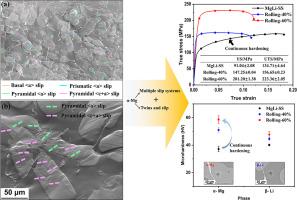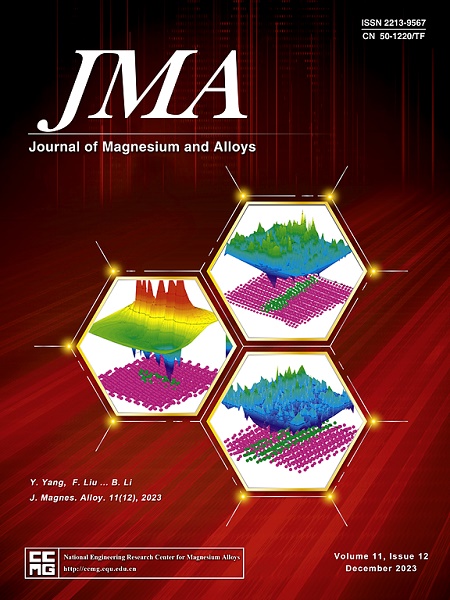Strengthening of Mg-Li alloy dominated by continuously hardened Mg phase during room temperature rolling
IF 15.8
1区 材料科学
Q1 METALLURGY & METALLURGICAL ENGINEERING
引用次数: 0
Abstract
The process of room temperature rolling is a straightforward and efficient method for producing high strength Mg-Li alloys, but the underlying strengthening mechanism remains unclear. In this study, we successfully enhanced the tensile properties of a novel dual-phase Mg-Li alloy through room temperature rolling, with a remarkable yield strength of 201 MPa and an elongation-to-failure of 14 %. Microhardness testing was conducted to evaluate the contribution of the Mg- and Li- phases to the improvement in strength. The results demonstrate that the hardness of Mg-phase reaches 60 HV, which is significantly higher than the 49 HV observed in Li-phase, indicating that the Mg-phase after rolling plays a pivotal role in enhancing material strength. The presence of a high density of dislocations stored in the Mg-phase emerges as the dominant factor contributing to improved strength in Mg-Li alloys. In-situ compression testing reveals that 〈c + a〉 slip activation and twinning-induced slip serve as internal mechanisms for continuous deformation and hardening within the Mg-phase. Despite numerous precipitated Mg-phase particles within the Li-phase matrix, the hardness analysis reveals minimal strain-induced phase transformation effects on the overall strength of the Al-free and Zn-free Mg-Li alloy. These findings provide valuable insights for designing and fabricating high-strength dual-phase Mg-Li alloys.

室温轧制过程中连续硬化镁相主导的镁锂合金强化
室温轧制工艺是生产高强度镁锂合金的一种直接而高效的方法,但其潜在的强化机制仍不清楚。在本研究中,我们通过室温轧制成功提高了新型双相镁锂合金的拉伸性能,屈服强度达到 201 兆帕,伸长率达到 14%。为了评估镁相和锂相对强度提高的贡献,还进行了显微硬度测试。结果表明,镁相的硬度达到 60 HV,明显高于锂相的 49 HV,这表明轧制后的镁相在提高材料强度方面发挥了关键作用。储存在镁相中的高密度位错是提高镁锂合金强度的主要因素。原位压缩测试表明,〈c + a〉滑移激活和孪生诱导滑移是镁相内持续变形和硬化的内部机制。尽管锂相基体中存在大量析出的镁相颗粒,但硬度分析显示,应变诱导相变对无铝无锌镁锂合金整体强度的影响微乎其微。这些发现为设计和制造高强度双相镁锂合金提供了宝贵的启示。
本文章由计算机程序翻译,如有差异,请以英文原文为准。
求助全文
约1分钟内获得全文
求助全文
来源期刊

Journal of Magnesium and Alloys
Engineering-Mechanics of Materials
CiteScore
20.20
自引率
14.80%
发文量
52
审稿时长
59 days
期刊介绍:
The Journal of Magnesium and Alloys serves as a global platform for both theoretical and experimental studies in magnesium science and engineering. It welcomes submissions investigating various scientific and engineering factors impacting the metallurgy, processing, microstructure, properties, and applications of magnesium and alloys. The journal covers all aspects of magnesium and alloy research, including raw materials, alloy casting, extrusion and deformation, corrosion and surface treatment, joining and machining, simulation and modeling, microstructure evolution and mechanical properties, new alloy development, magnesium-based composites, bio-materials and energy materials, applications, and recycling.
 求助内容:
求助内容: 应助结果提醒方式:
应助结果提醒方式:


